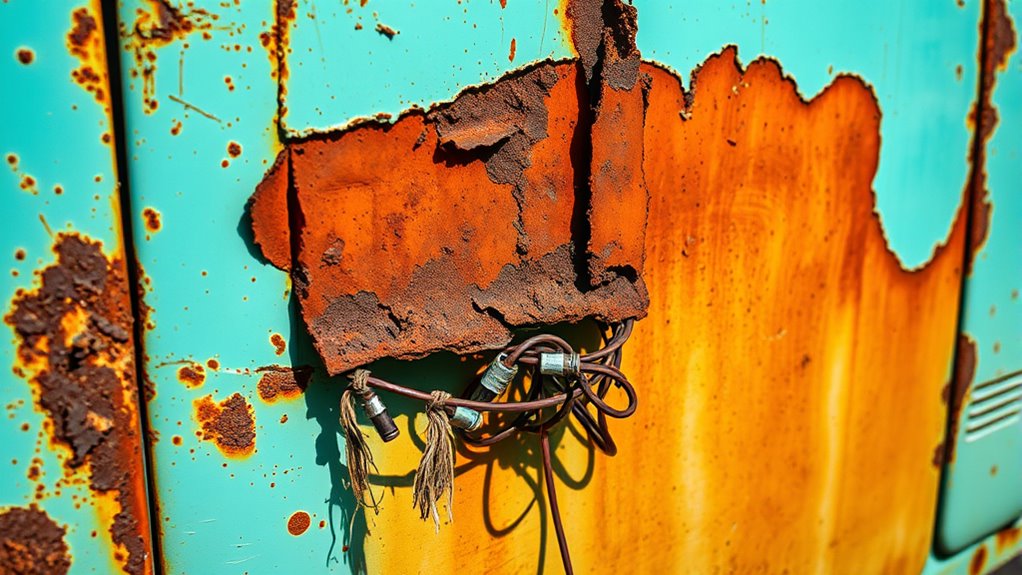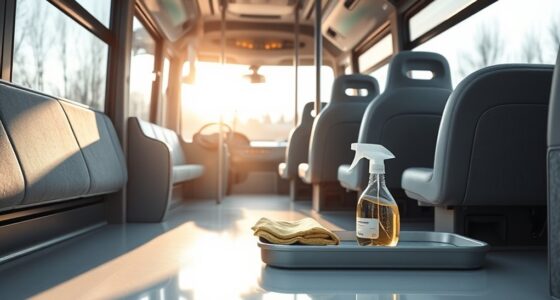To tackle rust, leaks, and old wiring in your VW Bus, start with thorough inspections to spot early issues in wheel wells, door sills, and seals. Sand off flaky paint and treat rust spots with rust converter, then seal with primer and paint. Replace worn gaskets and seals to prevent leaks, and upgrade outdated wiring with modern, heat-resistant cables, following proper diagrams. Keep things well-maintained to avoid future problems—stay tuned to learn detailed repair steps and tips.
Key Takeaways
- Regularly inspect and treat rust spots with rust converter, primer, and paint to prevent spread in areas like wheel wells and door sills.
- Identify and seal leaks around windows, doors, and roof using high-quality sealant; check drain holes to prevent water pooling.
- Remove old, brittle wiring and replace with modern, heat-resistant cables, ensuring critical circuits are prioritized and properly connected.
- Cut out severely corroded metal sections and weld in new patches to restore structural integrity of the VW bus.
- Maintain a clean, dry vehicle environment and perform routine inspections to detect early rust, leaks, and wiring issues for timely repairs.

Owning a classic VW Bus means dealing with its age-related issues, especially rust, leaks, and outdated wiring. These problems are common, but with the right approach, you can tackle them effectively through restoration tips and DIY repairs. Rust is often the most visible enemy, and it can spread quickly if left unchecked. To combat this, start by thoroughly inspecting your bus, focusing on areas like the wheel wells, floor pans, and door sills. Sand down any flaky paint and rust spots, then apply a rust converter to neutralize active corrosion. Once treated, sealing these areas with a high-quality primer and paint helps prevent future rust. For deeper corrosion, consider cutting out the affected sections and welding in new metal patches—this might sound intimidating, but it’s a straightforward DIY repair with the right tools and patience. Remember to wear protective gear and work in a well-ventilated space. Regular maintenance can also help prevent future issues by keeping the vehicle in optimal condition.
Inspect for rust, sand, treat, and seal to keep your VW Bus looking great and rust-free.
Leaks are another common issue, especially around windows, doors, and the windshield. To fix leaks, first identify their source by inspecting seals and gaskets. Old, brittle seals can be replaced with fresh rubber or silicone sealant, which is easy to apply and affordable. If you notice water pooling inside your bus, check the drain holes and clear them of debris. For leaks around the roof or windows, resealing with a high-quality automotive sealant will do the trick. Make sure the surface is clean and dry before applying to guarantee a good seal. Regular maintenance of door seals and window gaskets can prevent leaks from worsening and save you time and money in the long run. Understanding the importance of proper refrigeration cycle mechanics can also help when diagnosing electrical issues that might be causing leaks or other malfunctions.
Outdated wiring is a safety concern and can cause electrical failures or fires. When tackling old wiring, start by documenting your existing setup. Replace frayed or brittle wiring with modern, heat-resistant cables designed for automotive use. Focus on critical circuits first—lights, ignition, and essential accessories—before moving to less crucial systems. Use proper connectors and avoid splicing wires haphazardly. If you’re not comfortable working with electrical systems, consider consulting a professional, but many DIY enthusiasts find that following wiring diagrams and taking your time makes the job manageable. Upgrading your wiring not only enhances safety but also improves reliability, so your bus runs smoothly and you avoid frustrating breakdowns. Regular inspections and maintenance are key to keeping your electrical system in top condition and preventing costly repairs down the line.
Frequently Asked Questions
How Can I Prevent Rust From Forming Again After Repairs?
To prevent rust from forming again after repairs, you should focus on rust prevention and corrosion protection. Regularly wash your VW bus to remove dirt and moisture, and keep it dry, especially in hidden areas. Apply a high-quality rust inhibitor or protective coating to vulnerable spots, and consider waxing the exterior for added protection. Inspect and touch up any paint chips or scratches promptly to keep corrosion at bay.
Are There Modern Alternatives for Original Wiring Components?
You can find modern alternatives for original wiring components by upgrading to new wiring harnesses designed with circuit protection in mind. These harnesses often feature improved insulation and better durability, preventing issues like shorts or fires. When replacing your wiring, verify the harnesses are compatible with your VW bus’s electrical system. This upgrade not only boosts safety but also simplifies maintenance, ensuring your classic bus stays reliable on the road.
What’s the Best Way to Locate Hidden Rust Spots?
You might want to contemplate rust detection as your first step, as it helps uncover hidden corrosion before it worsens. Gently tap and listen for dull sounds, or use a magnet to spot thin or compromised areas. A thorough visual inspection, including inside panels and under carpets, reveals concealed rust spots. You can also employ a wire brush or a mirror to peek into tricky spots, ensuring you catch every sign of trouble early.
How Do I Safely Remove Old Wiring Without Damaging the Bus?
To safely remove old wiring, start by disconnecting the battery to prevent shocks and guarantee wiring safety. Carefully trace the wires, noting connections, then cut the wire connectors with insulated tools. Gently peel back the wiring harness without pulling on the wires, avoiding damage to the bus’s body. Use electrical tape or clips to keep the wiring organized during removal. Taking these steps ensures safe wire removal without harming your classic VW bus.
Can Leaks Cause Long-Term Interior Damage?
Leaks can definitely cause long-term interior damage. When water intrusion happens, it seeps into your vehicle’s interior, leading to rot, mold, and upholstery degradation over time. You might notice a musty smell or warped panels. To prevent this, fix leaks promptly and guarantee proper sealing. Addressing water intrusion early helps protect your bus’s interior from ongoing damage and keeps it looking and functioning great for years to come.
Conclusion
Just like the Road Warrior’s resilience, your VW bus can overcome rust, leaks, and worn wiring with patience and care. Remember, every fix is a step toward reclaiming your journey’s spirit. Don’t let age define your adventure—channel your inner hero, knowing that every challenge faced is a story worth telling. Keep your vintage legend alive, for in the end, it’s not just about the bus, but the memories you build along the way.









